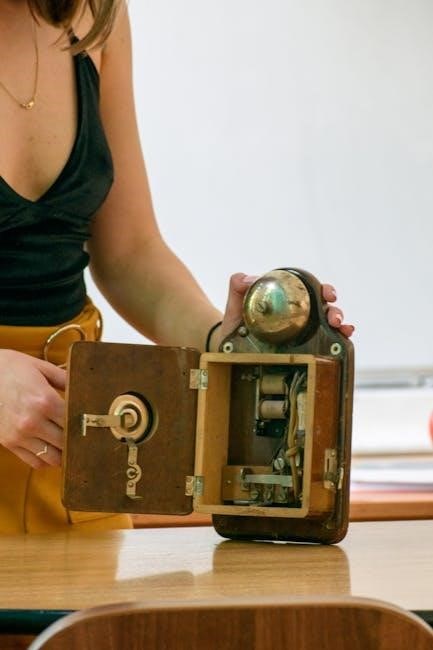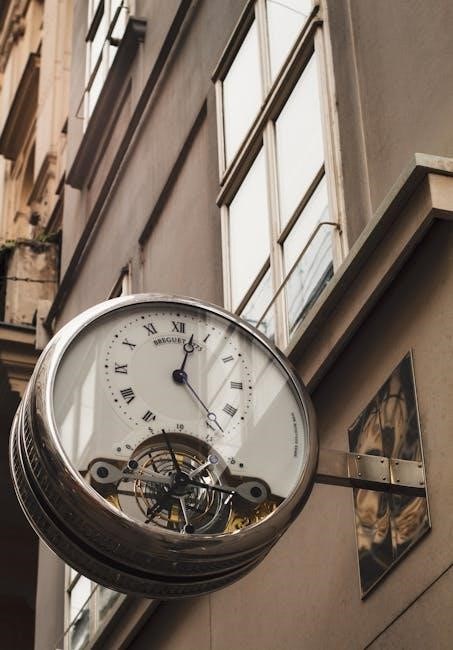Al Fajr clocks are specialized timekeeping devices designed to display accurate prayer times for Muslims worldwide. They often include features like Azan sound alerts and Qibla direction finders.
User manuals are crucial for understanding and utilizing all the features of Al Fajr clocks, including setting prayer times, adjusting alarms, and troubleshooting common issues, ensuring proper functionality.
Al Fajr clocks are specialized devices created to aid Muslims in maintaining their daily prayer schedules. These clocks go beyond simple timekeeping, offering a range of features tailored to Islamic practices. Their primary purpose is to accurately display the times for the five daily prayers (Fajr, Dhuhr, Asr, Maghrib, and Isha) based on the user’s geographical location. Many models incorporate an Azan feature, which emits the call to prayer at the appropriate times. Furthermore, some Al Fajr clocks include a Qibla compass, indicating the direction of the Kaaba in Mecca, allowing users to face the correct direction during prayer. They are designed to simplify adherence to Islamic prayer times in a convenient and accessible manner, promoting religious observance.
Overview of Al Fajr Clocks and Their Purpose
Al Fajr clocks are specialized devices created to aid Muslims in maintaining their daily prayer schedules. These clocks go beyond simple timekeeping, offering a range of features tailored to Islamic practices. Their primary purpose is to accurately display the times for the five daily prayers (Fajr, Dhuhr, Asr, Maghrib, and Isha) based on the user’s geographical location. Many models incorporate an Azan feature, which emits the call to prayer at the appropriate times. Furthermore, some Al Fajr clocks include a Qibla compass, indicating the direction of the Kaaba in Mecca, allowing users to face the correct direction during prayer. They are designed to simplify adherence to Islamic prayer times in a convenient and accessible manner, promoting religious observance.

Importance of User Manuals for Optimal Use
User manuals are essential for maximizing the potential of Al Fajr clocks. These manuals provide detailed instructions on setting up the clock, configuring prayer time calculations, and utilizing advanced features. Without a manual, users may struggle to accurately set the time, select their city, or adjust calculation methods, leading to incorrect prayer times. Manuals also guide users on setting alarms, using the Hijri calendar, and troubleshooting common problems like time accuracy issues or Azan sound malfunctions. By following the instructions in the user manual, individuals can ensure their Al Fajr clock functions correctly, providing them with reliable and precise prayer time information, enhancing their worship experience.
The initial setup involves accurately setting the current time and date on the Al Fajr clock, ensuring it aligns with your local time zone for correct prayer time calculations.
Choosing your city and corresponding time zone is crucial for the clock to calculate prayer times accurately based on your location. This step personalizes the clock’s functionality.
To set the time and date on your Al Fajr clock, locate the “SET” button. Press and hold it until the display flashes. Use the up/down arrows to adjust the year, then press “SET” again to confirm. Repeat this process for the month, day, hour, and minute. Ensure you select the correct AM/PM setting. After setting the minute, press “SET” one last time to save the settings. Some models may have a daylight saving time option; ensure it is correctly configured for your region. Verify the displayed time and date accuracy after completing these steps to guarantee correct prayer time calculations. The clock will show the current date 05/19/2025 and time 18:19:23 ().

Initial Setup and Basic Functions
Setting the Time and Date
To set the time and date on your Al Fajr clock, locate the “SET” button. Press and hold it until the display flashes. Use the up/down arrows to adjust the year, then press “SET” again to confirm. Repeat this process for the month, day, hour, and minute. Ensure you select the correct AM/PM setting. After setting the minute, press “SET” one last time to save the settings. Some models may have a daylight saving time option; ensure it is correctly configured for your region. Verify the displayed time and date accuracy after completing these steps to guarantee correct prayer time calculations. The clock will show the current date 05/19/2025 and time 18:19:23 ().
Selecting Your City and Time Zone
To select your city and time zone, consult the included city code list. Press the “CITY” button and enter the corresponding code using the up/down arrows. Confirm your selection by pressing “SET.” For time zone adjustments, navigate to the time zone setting (often found in the settings menu) and adjust accordingly. Ensure that you select the correct city to guarantee accurate prayer time calculations. If your city is not listed, choose the nearest major city within your time zone. Some clocks may automatically adjust for daylight saving time based on the selected city, but double-check to ensure accuracy.

Understanding Prayer Time Calculations
Al Fajr clocks calculate prayer times based on astronomical algorithms, considering the sun’s position relative to your selected city and its latitude and longitude coordinates.
Adjusting Calculation Methods (Taqweem) for Fajr and Isha
To adjust the Fajr and Isha calculation method, access the “Taqweem” settings in the menu. Select the appropriate method (e.g., Muslim World League, Egyptian) for your region.
How Al Fajr Clocks Calculate Prayer Times
Al Fajr clocks utilize sophisticated algorithms rooted in Islamic jurisprudence and astronomical data to accurately determine daily prayer times. These calculations consider geographical location, specifically latitude and longitude, alongside established conventions like the angle of the sun below the horizon at Fajr and Isha. The clock’s programming incorporates these variables, referencing pre-calculated tables or employing real-time computation to provide precise timings for each prayer.
Furthermore, the selection of a specific “Taqweem” or calculation method significantly impacts the final prayer times. Different Islamic organizations and regions adhere to varying interpretations of these astronomical parameters, leading to slight discrepancies. By offering multiple Taqweem options, Al Fajr clocks enable users to align their prayer schedules with local customs and preferences. Understanding these fundamental principles allows users to appreciate the accuracy and adaptability of Al Fajr clock technology.
Adjusting Calculation Methods (Taqweem) for Fajr and Isha
Al Fajr clocks allow users to fine-tune prayer time calculations, particularly for Fajr and Isha, by selecting from various “Taqweem” methods. These methods represent different scholarly interpretations of when dawn (Fajr) truly begins and when night (Isha) has fully descended, affecting the angle of the sun below the horizon used in calculations.
Accessing the clock’s settings menu enables users to choose a Taqweem that aligns with their local mosque or preferred Islamic authority. Common options include the Muslim World League, Islamic Society of North America, and Egyptian General Authority of Survey. The manual provides detailed explanations of each Taqweem, empowering informed decisions.
Selecting the appropriate Taqweem ensures prayer times are consistent with community practices. Experimentation may be needed to find the most suitable setting. Always consult with local religious leaders for guidance on the preferred Taqweem in your region.

Navigating the Clock Display

The main screen typically displays the current time, date (Gregorian and Hijri), and the next prayer time. Icons may indicate alarm status and other active functions.

Understanding the Main Screen Information
The primary display of an Al Fajr clock provides essential information at a glance. Typically, you’ll find the current time prominently displayed, often in both 12-hour (AM/PM) and 24-hour formats for user preference. Alongside the time, the Gregorian date is usually shown, and many models also include the corresponding Hijri date, catering to the Islamic calendar.
A key feature is the indication of the next prayer time, such as Fajr, Dhuhr, Asr, Maghrib, or Isha. Some clocks will clearly label which prayer time is upcoming, while others might use icons or abbreviations. Additionally, the screen might show symbols representing active alarms, whether it’s the daily alarm or specific prayer alarms like the Fajr alarm. Volume levels and other setting indicators might also be present, ensuring you are fully informed about your clock’s current state and configuration. Pay close attention to the manual to fully understand all indicators.
Displaying Remaining Time to Next Azan
A crucial function of Al Fajr clocks is showing the time remaining until the next Azan, allowing users to plan their day around prayer times. This information is typically displayed in hours and minutes, counting down in real-time. The clock calculates this based on the selected city and the chosen prayer time calculation method (Taqweem).
The display might alternate between showing the specific prayer name (e.g., Fajr) and the remaining time, or it may show both simultaneously. This feature helps users anticipate prayer times and ensure they are prepared. Some models also offer a visual representation, such as a progress bar, to illustrate the approaching Azan. Understanding this display is vital for timely prayer observance, and the user manual provides specific details on how this function operates on your particular Al Fajr clock model, ensuring accurate and reliable information.

Setting Alarms and Reminders
Al Fajr clocks enable users to set a daily alarm, providing a regular wake-up call or reminder for daily tasks, independent of prayer times, enhancing daily organization.
Configuring the Daily Alarm
To configure the daily alarm on your Al Fajr clock, first, locate the alarm settings within the clock’s menu. This can usually be accessed by pressing the “Set” or “Mode” button, followed by navigating to the “Alarm” option. Once you are in the alarm settings, you can set the desired time for the alarm to ring daily. You will typically adjust the hour and minute using the up and down buttons. Some models might offer the option to select specific days of the week for the alarm to be active.
After setting the time, ensure that the alarm is activated. This is often done by toggling an “On/Off” switch within the alarm settings. Test the alarm to confirm it rings at the set time.
Volume adjustments are also typically available within the alarm configuration.
Setting Specific Prayer Alarms (Fajr Alarm)
Configuring the Fajr alarm on your Al Fajr clock is a straightforward process designed to ensure you wake up for the first prayer of the day. Begin by accessing the alarm settings, often found through the “Set” or “Mode” button, then navigate to the “Fajr Alarm” option. Unlike the daily alarm, the Fajr alarm is linked to the calculated Fajr prayer time.
You can set the alarm to ring at the exact Fajr time or a specific number of minutes before or after it. Adjust this offset using the up and down buttons. This feature is useful for those who prefer to wake up slightly earlier to prepare for prayer.
Once the offset is set, ensure the Fajr alarm is activated. Test the alarm to verify it triggers correctly relative to the displayed Fajr time. The volume can be adjusted within the main settings.

Advanced Features and Customization
Al Fajr clocks allow manual adjustments to Azan times. This accommodates unique local conditions or preferences, ensuring prayer times align with specific community practices.
Adjusting Azan Times Manually
Al Fajr clocks offer users the capability to manually adjust Azan times, providing flexibility to align with specific local customs or preferences. This feature is particularly useful in regions where standard calculation methods may not accurately reflect actual prayer times due to unique geographical or religious factors. The manual adjustment settings typically allow users to modify each prayer time (Fajr, Dhuhr, Asr, Maghrib, and Isha) by adding or subtracting a certain number of minutes.
To access this function, users generally navigate through the clock’s menu using designated buttons, locate the Azan time adjustment settings, and then increment or decrement the minutes for each prayer time as needed. It’s essential to consult local mosque authorities or religious experts to determine the appropriate adjustments for accurate prayer time adherence within a specific community; The changes made are stored in the clock’s memory and will be applied to the daily prayer time calculations.
Using the Hijri Calendar
Al Fajr clocks often incorporate the Hijri calendar, the lunar calendar used in Islam, alongside the Gregorian calendar. This allows users to keep track of important Islamic dates, such as Ramadan, Eid al-Adha, and other religious events. To use the Hijri calendar feature, users typically navigate through the clock’s display settings to view the current Hijri date.
The clock’s manual provides instructions on how to adjust the Hijri date if it’s not synchronized with the actual Islamic calendar, as slight discrepancies can occur due to varying moon sighting practices. Some models automatically update the Hijri date based on pre-programmed algorithms, while others require manual adjustments. Understanding how to properly set and utilize the Hijri calendar ensures users stay informed about significant dates within the Islamic year. The adjustment settings typically allow users to modify the year, month, and day.

Troubleshooting Common Issues
If your Al Fajr clock displays inaccurate prayer times, ensure the correct city and time zone are selected. Check and adjust the calculation method (Taqweem) in the settings.
Problems with Time Accuracy
If you encounter issues with time accuracy on your Al Fajr clock, several factors could be contributing. First, verify that you have correctly set the city and time zone for your location. Incorrect settings will inevitably lead to inaccurate prayer time calculations. Next, examine the selected Taqweem method, ensuring it aligns with the prevalent practice in your region. Different calculation methods can yield variations in prayer times, particularly for Fajr and Isha.
Consider daylight saving time adjustments if applicable in your area, as these can shift the clock’s time and consequently affect prayer timings. Finally, if the clock has been running for a prolonged period, a reset might be necessary. Refer to the user manual for instructions on how to reset the device to its default settings and recalibrate the time. Always double-check against a reliable source of prayer times to ensure accuracy.
Azan Sound Issues and Volume Control
If your Al Fajr clock is experiencing problems with the Azan sound, begin by checking the volume control. Ensure that the volume is turned up to an audible level and that the mute function is not activated. If the sound is still absent, verify that the correct Azan sound is selected within the clock’s settings. Some models offer multiple Azan options. Next, inspect the speaker for any obstructions or damage. Dust or debris can sometimes interfere with sound output.
If the Azan sound is distorted or of poor quality, try resetting the clock to its factory settings, as this can sometimes resolve software glitches affecting audio. If problems persist, consult the troubleshooting section of your user manual or contact Al Fajr customer support for further assistance. Remember to check the battery level, as a low battery can sometimes affect sound performance.
